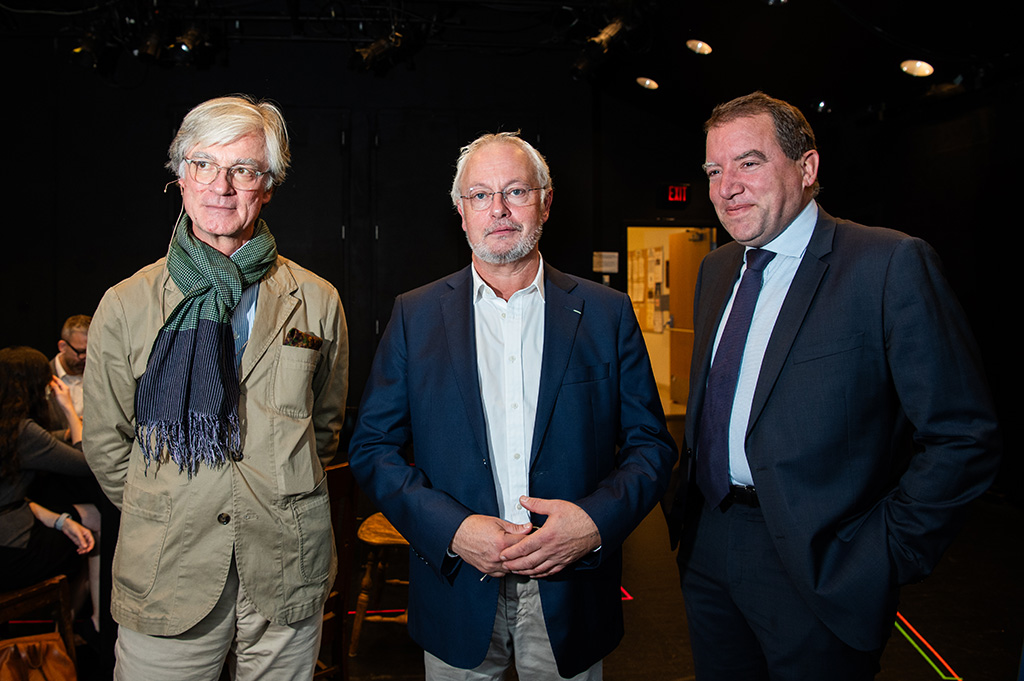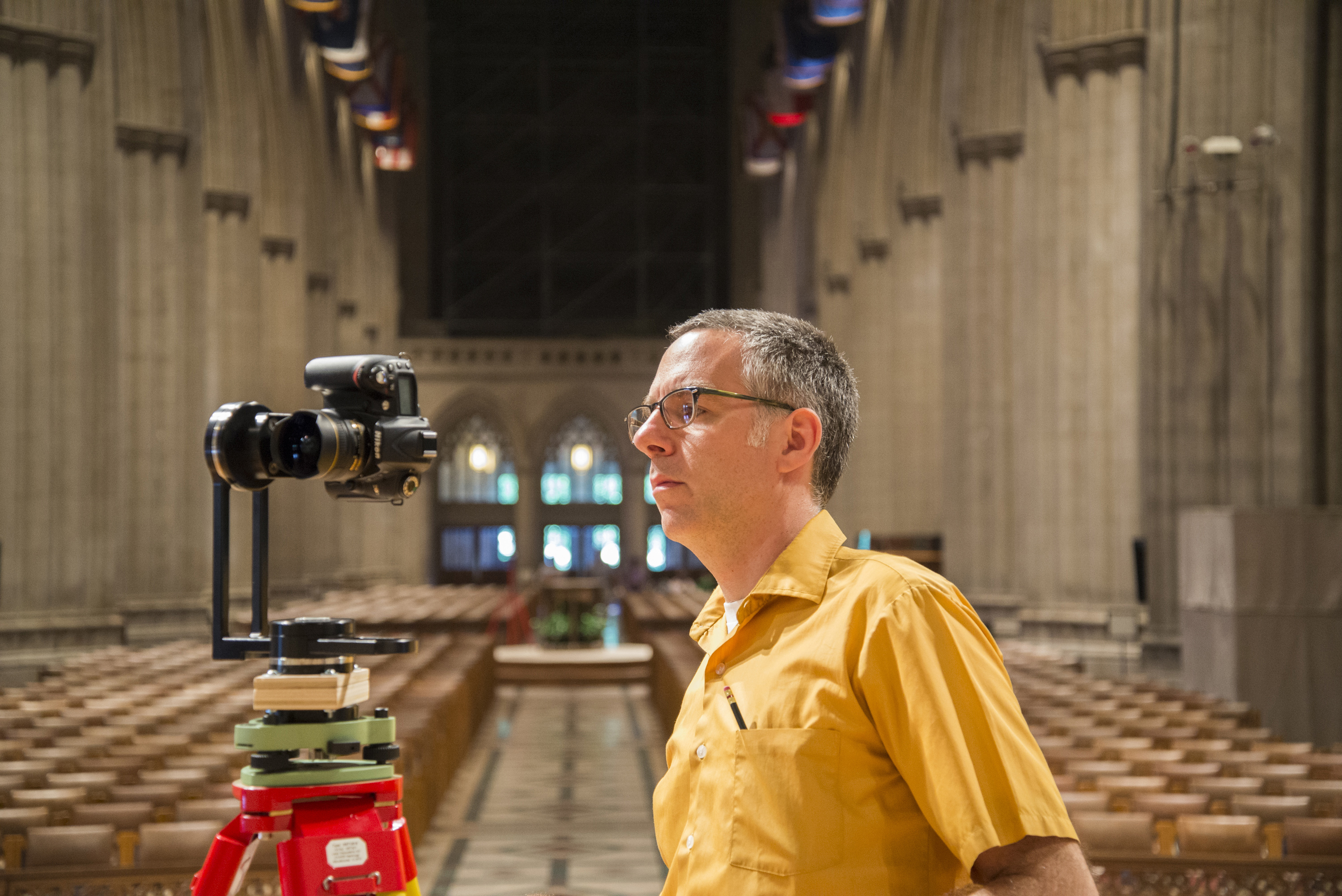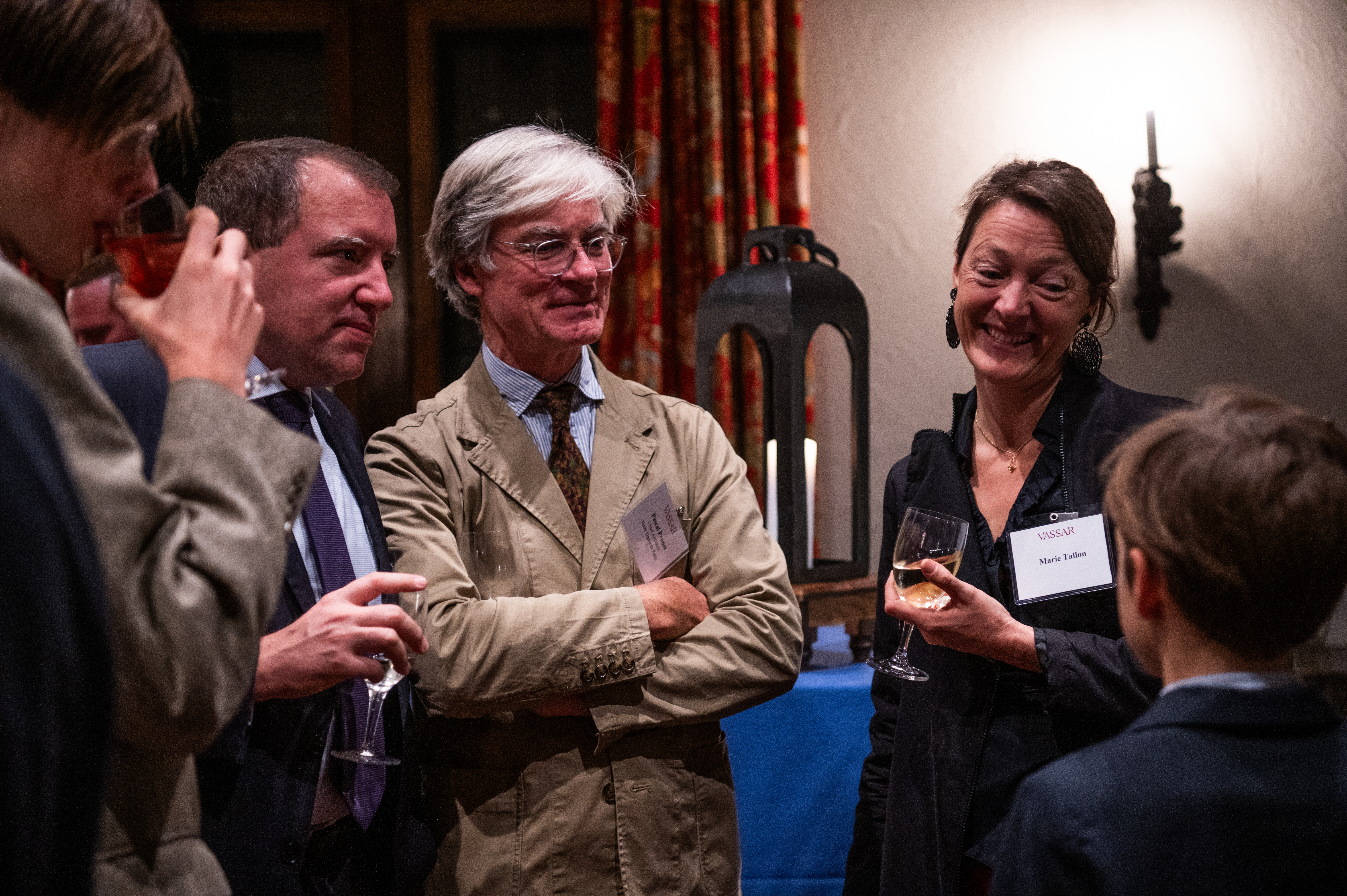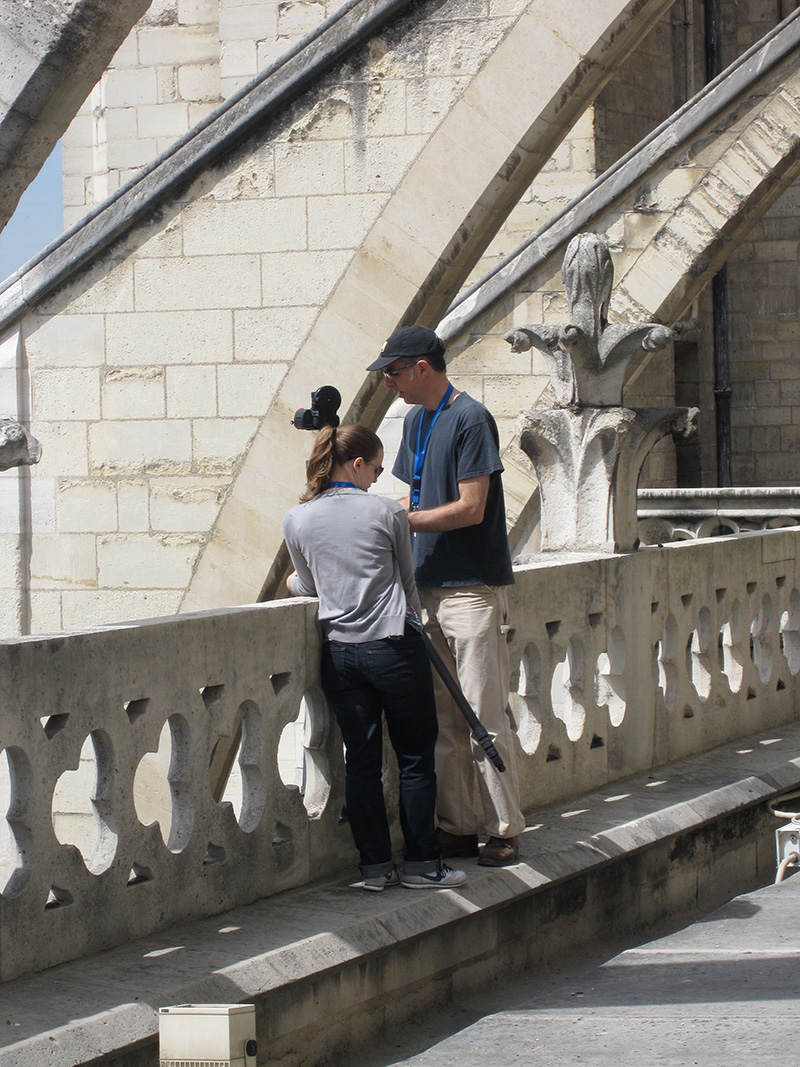Leaving a Trace
It has been five years since Associate Professor of Art Andrew Tallon, the charismatic teacher and historian of medieval architecture, passed away, but his pathbreaking research lives on. The 3D laser scan of Notre-Dame of Paris that Tallon produced in 2010 has already been instrumental in the reconstruction of the Gothic cathedral, damaged in a catastrophic fire that broke out on April 15, 2019.
This fall semester, two of the three architects responsible for rebuilding the cathedral, Philippe Villeneuve, Architect-in-Chief of Historic Monuments in charge of Notre-Dame, and fellow restoration architect Pascal Prunet, delivered a Claflin Lecture at Vassar’s Martel Theater about their efforts to shore up, conserve, and restore the cathedral since the fire. Their visit to Vassar was made possible by the Friends of Notre-Dame de Paris in honor of Andrew Tallon. The third, Rémi Fromont, remained in Paris, where he is overseeing the final stages of the reconstruction of the roof and spire. This phase of the project is scheduled to conclude on December 8, 2023, when the new rooster Villeneuve designed will be installed atop the spire.
“[Tallon’s] scan enabled us to reconstruct the vaults without any hesitation from a dimensional or formal standpoint, and it also granted us total freedom to understand how [the cathedral] was made, to be able to rebuild it in a thoughtful, intellectual, and intelligent way,” Villeneuve said during the recent visit to Vassar.

Tallon arrived at Vassar in 2007. Over the next three years, as part of a major grant he and Columbia art history professor Stephen Murray secured from the Mellon Foundation to develop an innovative website called Mapping Gothic France, Tallon selected two Vassar students annually to conduct summer fieldwork with him, Murray, and Murray’s doctoral students. The Vassar students Tallon selected were chosen through a competitive application process to participate in the digital humanities project and were responsible for taking 360° panoramic photographs of the scores of Romanesque and Gothic buildings the team visited in regions throughout France. Jessica Lentner ’09 and Kappy Mintie ’09 photographed sites in Champagne in 2008; Sofia Gans ’09 and Alexandra Thom ’09 focused on Normandy in 2009; and Ani Kodjabasheva ’12 and Lindsay Cook ’10 concentrated on Burgundy in 2010.
That year, Tallon also scanned Notre-Dame. The primary reason he wanted to produce the laser survey was to study the cathedral’s structure, especially its flying buttresses, which had been rebuilt over the centuries. During Tallon’s lifetime, the 3D scan was put to multiple uses, including to produce a new ground plan of Notre-Dame and a series of illustrations presenting hypothetical reconstructions of historical states of the cathedral for a monograph he co-authored with Sorbonne art history professor Dany Sandron, first published in French in 2013. The book’s illustrations and captions were adapted for a trilingual display sponsored by Vassar’s President’s International Advisory Council, on view in the cathedral’s ambulatory from 2014 until the 2019 fire. It was viewed by more than 30 million visitors. An English-language edition of Tallon and Sandron’s book subsequently appeared as Notre Dame Cathedral: Nine Centuries of History, trans. Lindsay Cook (Penn State University Press, 2020).

Photo: WNC 2014/ Craig W. Stapert.
Laser scanning Notre-Dame, photographing it for Mapping Gothic France, and viewing its stonework from the upper terraces led Tallon to worry about the building’s structural integrity. André Finot, the cathedral’s spokesperson, came to Notre-Dame from a career in the advertising industry. Not long after his arrival, Tallon invited him to climb the cathedral to warn him about the state of the building. Finot remembered Tallon telling him, “You see all these stones? This building is in danger—you need to do something. You should create a foundation, and everybody will help, because everybody loves Notre-Dame. Have a good day!”
It may have sounded simple, but complicating matters was the fact that, by law, the city of Paris owns the land on which Notre-Dame sits, the French state owns the building itself, and the Catholic Church is responsible for maintaining the cathedral. With so many stakeholders involved, “nobody wanted to pay for anything,” Finot recalled. In his view, what ultimately moved the needle was a letter Tallon addressed to Cardinal André Vingt-Trois, then archbishop of Paris, pleading with him to support the creation of what would eventually become the nonprofit Friends of Notre-Dame de Paris. Vassar alums championed this initiative both before and since the organization was officially founded in 2017, among them Nora Ann Wallace ’73 and Lorna Bade Goodman ’63, P’88, GP’22.

When fire ripped through Notre-Dame’s roof on April 15, 2019, the restoration Tallon had helped set in motion was well underway. That very morning work began on one of the flying buttresses he had feared might fail. It was a lucky break that earlier that same week, sixteen of the copper statues adorning the spire were removed for conservation treatment and were not there when the fire broke out. They represent the twelve apostles and the four evangelists, integral to the spire restoration architect Eugène Viollet-le-Duc designed in the late 1850s. The carpentry supporting these figures was inspired, in part, by the base of the medieval spire, which still lingered under the roof in the mid-19th century, as University of Wisconsin-Whitewater art history professor Lynn T. Courtenay ’65 demonstrated in a noteworthy 1989 journal article.
The fire melted the lead roof tiles, destroyed the timber framework of both the 19th-century spire and the 13th-century nave and choir roofs, and weakened the stones its flames licked—but it could not claim the apostle and evangelist statues. They have since been restored, and, at the time of writing, they are all on view at the Cité de l’architecture et du patrimoine, the cultural heritage museum in Paris. Among these towering copper figures is St. Andrew, dedicated both to Cardinal André Vingt-Trois and to the memory of Andrew Tallon. When he visits the museum and sees the restored statue with Tallon’s name written on the plaque, Finot said, he feels “thankful for what [Tallon] did for Notre-Dame.”

Photo: Courtesy of Lindsay Cook.
The three architects bring a wealth of experience from their time restoring historic monuments in various regions of France, including some in which wars and revolutions have left their mark, allowing for a modicum of creative freedom. The task is different, however, “when you work on icons,” according to Prunet. “At Notre-Dame, we are doing an enormous amount of work, but we are not doing creative work; we are putting things back together again,” he continued. “What we’re doing isn’t very personal,” Villeneuve added. Tallon’s laser scan has enabled the architects to allow Notre-Dame to “speak for itself,” according to Villeneuve.
Tallon had sent a copy of his point cloud (collection of data points plotted in 3D space) to Villeneuve’s predecessor, Benjamin Mouton, before the latter retired in 2013, and after the 2019 fire, Marie Tallon saw to it that Villeneuve, Prunet, and Fromont had access to her late husband’s work. During their lecture and in a follow-up interview conducted the next day, Villeneuve and Prunet said that Tallon’s scan—which Prunet called an “exact trace” of the state of the building at the time it was scanned—has been used in numerous ways since the fire. For example, it aided design of the wooden centering custom-made to cradle each unique flying buttress and rib vault and to rebuild the damaged vaults and the sole transverse arch destroyed when the tip of the spire separated from its base and fell westward, becoming a projectile that crashed into the nave.
“Andrew Tallon’s point cloud, well, it’s a bit like listening to a Mahler symphony,” said Prunet, alluding to the scan’s sublime scale and complexity. Extending the musical metaphor, Prunet continued, “It’s a recording,” but one that “needs to be decrypted.”
After the fire, many news outlets, including the Atlantic, Forbes, CNN and others, acknowledged the utility of Tallon’s research in helping to rebuild the cathedral.
Lindsay S. Cook ’10 earned her Ph.D. from Columbia University. She was Visiting Assistant Professor of Art at Vassar from 2018–2020, and she is currently Assistant Teaching Professor of Architectural History in the Department of Art History at the Pennsylvania State University.